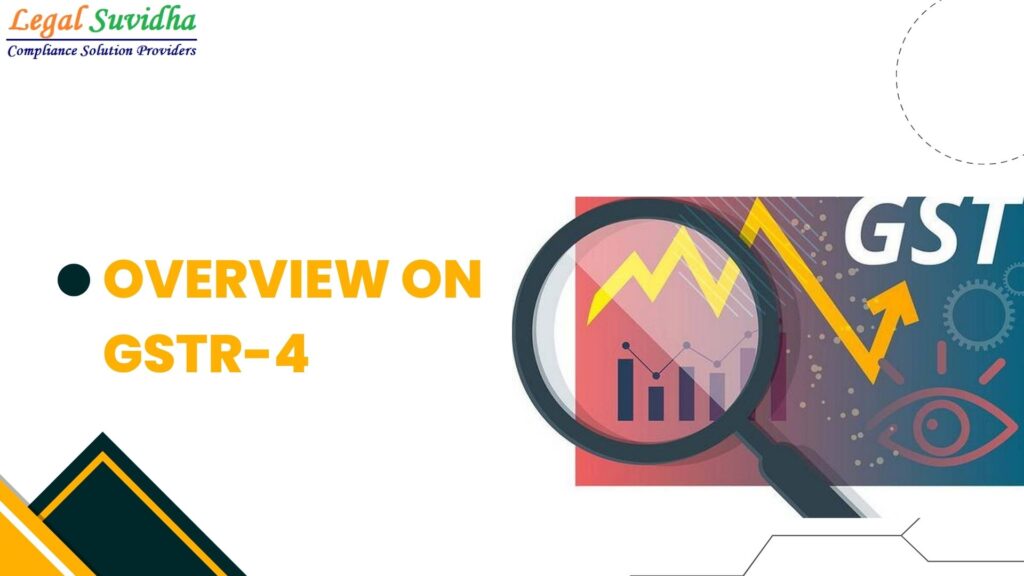KNOW EVERYTHING ABOUT GSTR-4
GSTR-4 is a GST Return that has to be filed by a composition dealer. Unlike a normal taxpayer who needs to furnish 3 monthly returns, a dealer opting for the composition scheme is required to furnish only 1 return which is GSTR 4 once in a year by 30th of April, following a financial year.
Composition Scheme was introduced for small taxpayers with the aim of providing relief from cumbersome and difficult procedure prescribed for regular taxpayers.
Section 10 of the CGST Act prescribes eligibility conditions for obtaining registration as a composition tax payer.
A plain reading of section 10 and the relevant rules which has undergone frequent amendments from time to time will show how difficult it is for a small tax payer to understand the basic provisions
The annual return in GSTR-4 is to be filed on or before 30th April for the preceding financial year. This date is too early as no time is left for reconciliation of accounts with the selling dealers.
Annual returns for the year 2019-20 were filed in a hurried manner leaving scope for certain omissions and commissions.
While filing the annual returns for F/Y 2019-20 and 2020-21 the portal never flagged any error regarding any mistake if any in the return.
The taxpayer in majority of the cases submitted the return as auto populated on the portal
This is quite difficult for people who keep manual books of account. For the previous financial year, the annual return in GSTR-4 must be filed on or before April 30th.
This deadline is too soon because there isn’t enough time to reconcile accounts with the selling dealers.
Annual returns for the 2019-20 fiscal year were filed in a hasty manner, providing room for omissions and commissions.
When filing yearly reports for fiscal years 2019-20 and 2020-21, the site never highlighted any errors or errors in the return. In the vast majority of situations, the taxpayer used the portal’s auto-fill feature to submit the return.
Composition taxpayers filing annual returns
Negative Liability in GSTR-4 Instances have been noticed where taxpayers are reporting negative liability in their GSTR-4. Background: Beginning in FY 2019-20, composition taxpayers must pay their liabilities quarterly using Form GST CMP-08, whereas the GSTR-4 Return must be completed annually after the conclusion of the fiscal year
Reason for Negative Liability in GSTR4:
Under relevant tax rates, the liability for the entire year must be recorded in GSTR-4. Table 6 of GSTR-4 must be completed by all taxpayers.
If there is no liability, the table can be populated with a value of ‘0’. If no obligation is reported in table 6, it is assumed that no liability must be paid, even if the taxpayer paid the liability using Form GST CMP-08.
In such instances, the liability paid by GST CMP-08 becomes excess tax paid, and it is transferred to the Negative Liability Statement to be used for future tax periods’ liabilities.
If there is a negative balance, you must deposit the amount equivalent to the negative balance in the cash ledger as soon as possible.
If you have already paid the amount that is now debited in your cash ledger or negative liability statement by included it in any return or statement, you can request a refund by filling out Form GST RFD-01.
Certain taxpayers complained on the GSTIN portal that no tax was due because the DRC-03 was only filed to offset the negative tax liability as a precaution against the aforementioned negative tax liability being used accidentally against the tax liability of later periods.
If there is a negative balance and you have already paid the amount, now being debited in cash ledger by including the same in any return/statement, the same can be claimed as a refund by filing a refund application in Form GST RFD-01 in respect of the excess tax paid.
Taxpayers have been put in a tough and hard situation because it is difficult for small firms to deposit the tax again and request for a refund later.
Taxpayers are not permitted to file GSTR-4 for the fiscal year 2021-22 unless they comply with the GSTIN’s resolution. Late fine of Rs. 50/- per day are charged if GSTR-4 is not filed on time.
Despite the fact that no tax was due, this is exacerbating the tax payers’ difficulties.
The due date for GSTR-4 should be the same as the due date for GSTR-9, or the due date should be appropriately changed.
The tax burden arises solely as a result of technical issues with the portal, which should be remedied as soon as possible. The deadline for filing GSTR-4 for the fiscal year 2021-22 should be appropriately extended till GSTIN finds a solution.


![Received an Income Tax Notice in India? Don’t Panic — Here’s Exactly What to Do [2025 Guide] 1 Income Tax Notice](https://legalsuvidha.com/wp-content/uploads/2025/12/Income-Tax-Notice.png)
![Cyber Crime FIR in India: How to File Complaint for Online Fraud, Banking Fraud & Digital Harassment [2025 Guide] 2 Cyber Crime Complaint](https://legalsuvidha.com/wp-content/uploads/2025/12/Cyber-Crime-Complaint.png)
![Trademark Infringement in India: How to File Legal Action & Protect Your Brand [2025 Guide] 3 Tradenark Infrigement](https://legalsuvidha.com/wp-content/uploads/2025/12/Tradenark-Infrigement.png)
![Property Title Verification in India: How to Check Clear Title in 7 Steps [Avoid Property Fraud – 2025 Guide] 4 Property Titles Verification](https://legalsuvidha.com/wp-content/uploads/2025/12/Property-Titles-Verification.png)



